Critical Review of Performance Management Fundamentals: Report
VerifiedAdded on 2022/08/14
|7
|1466
|11
Report
AI Summary
This report provides a critical review of performance management fundamentals, focusing on how innovation and learning become critical performance indicators within an organization. The author examines how a shift towards innovation and knowledge creation influences work processes, leading to more non-routine tasks and increased interdependency among employees. The report emphasizes the importance of a contingent performance management system that prioritizes learning and group processes, as well as both qualitative and quantitative goals. The author discusses the implications of project management and presents findings from empirical studies, highlighting the need for a better performance management system to enhance innovation and learning. The analysis covers the changing nature of work, including increased ambiguity and complexity, and the need for employee empowerment and decision-making at the local level. Furthermore, the report emphasizes the role of cooperation, mutual adjustment, and knowledge sharing in fostering innovation and creating unique products and services, ultimately contributing to a competitive advantage for the firm. The report also delves into how performance management systems can be adapted to accommodate non-routine work and employee interdependence, with a focus on problem-solving capabilities and knowledge creation.

Running head: PERFORMANCE MANAGEMENT FUNDAMENTALS
PERFORMANCE MANAGEMENT FUNDAMENTALS
Name of the Student
Name of the University
Author Note:
PERFORMANCE MANAGEMENT FUNDAMENTALS
Name of the Student
Name of the University
Author Note:
Paraphrase This Document
Need a fresh take? Get an instant paraphrase of this document with our AI Paraphraser

1PERFORMANCE MANAGEMENT FUNDAMENTALS
Critical Review of the Article
The following article deals with performance management where both innovation and
learning aims to stand out critical performance aspect. The article highlights the point that
organization performance indicators are merely shifting towards innovation and building
knowledge. It merely results in much more routine of work and a much bigger value of
dependency among the workers. Performance management system emphasizes on learning and
different group process along with qualitative and qualitative goals (DeNisi and Murphy 2017).
Employee are merely of three R&D department for a firm giving much-developed
communication system. It is merely required for four systems of PM along with four stages that
is accountability, appraisal, award and engagement. If both the given terms that are innovation
and learning becomes an important aspect of organization leading performance, then it will
ultimately have an effect on the performance management. A comparison has been done
regarding the implication of project management along with result that is obtained from different
empirical study. Much of the focus is given on the attitude for a much better PM system required
for improving innovation and learning (Gerrish 2016). Most of the organization around the globe
come up with innovation and learning as the best performance indicator that operates in dynamic
environment. It merely helps in dealing with the complex and ambiguous process of transaction.
To tackle this particular situation, organization are coming up with some strategies. It is not only
for dealing with environment demand properly but also completely shaping the demand of
environment (Ahmed et al. 2016). The point should be taken into account that innovation stand
out to be innovation for the major aspect in long-term success.
Organization which looks for innovation comes up with competitive advantage if and
only if they have new ideas and even create new services and product. All the given strategies
Critical Review of the Article
The following article deals with performance management where both innovation and
learning aims to stand out critical performance aspect. The article highlights the point that
organization performance indicators are merely shifting towards innovation and building
knowledge. It merely results in much more routine of work and a much bigger value of
dependency among the workers. Performance management system emphasizes on learning and
different group process along with qualitative and qualitative goals (DeNisi and Murphy 2017).
Employee are merely of three R&D department for a firm giving much-developed
communication system. It is merely required for four systems of PM along with four stages that
is accountability, appraisal, award and engagement. If both the given terms that are innovation
and learning becomes an important aspect of organization leading performance, then it will
ultimately have an effect on the performance management. A comparison has been done
regarding the implication of project management along with result that is obtained from different
empirical study. Much of the focus is given on the attitude for a much better PM system required
for improving innovation and learning (Gerrish 2016). Most of the organization around the globe
come up with innovation and learning as the best performance indicator that operates in dynamic
environment. It merely helps in dealing with the complex and ambiguous process of transaction.
To tackle this particular situation, organization are coming up with some strategies. It is not only
for dealing with environment demand properly but also completely shaping the demand of
environment (Ahmed et al. 2016). The point should be taken into account that innovation stand
out to be innovation for the major aspect in long-term success.
Organization which looks for innovation comes up with competitive advantage if and
only if they have new ideas and even create new services and product. All the given strategies
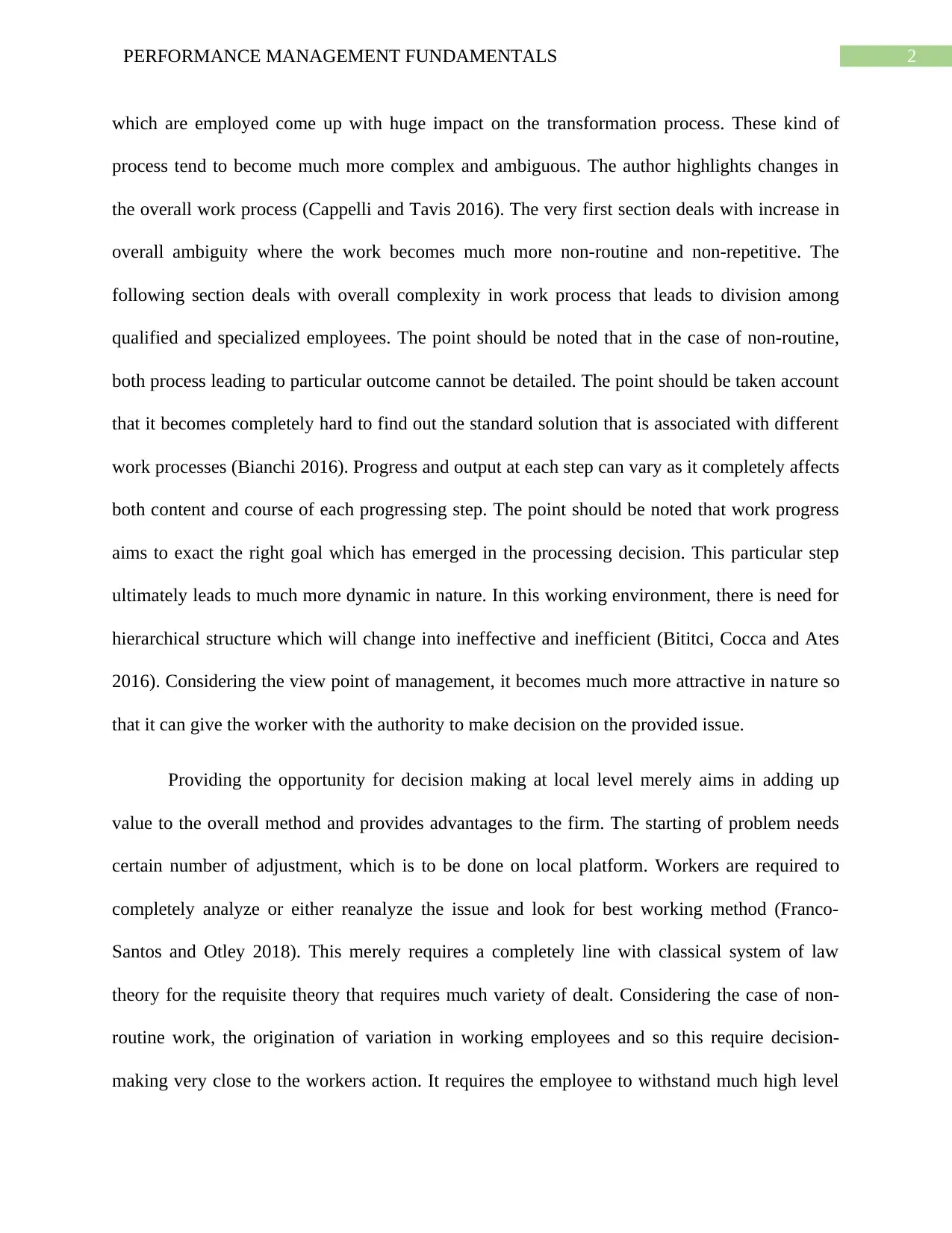
2PERFORMANCE MANAGEMENT FUNDAMENTALS
which are employed come up with huge impact on the transformation process. These kind of
process tend to become much more complex and ambiguous. The author highlights changes in
the overall work process (Cappelli and Tavis 2016). The very first section deals with increase in
overall ambiguity where the work becomes much more non-routine and non-repetitive. The
following section deals with overall complexity in work process that leads to division among
qualified and specialized employees. The point should be noted that in the case of non-routine,
both process leading to particular outcome cannot be detailed. The point should be taken account
that it becomes completely hard to find out the standard solution that is associated with different
work processes (Bianchi 2016). Progress and output at each step can vary as it completely affects
both content and course of each progressing step. The point should be noted that work progress
aims to exact the right goal which has emerged in the processing decision. This particular step
ultimately leads to much more dynamic in nature. In this working environment, there is need for
hierarchical structure which will change into ineffective and inefficient (Bititci, Cocca and Ates
2016). Considering the view point of management, it becomes much more attractive in nature so
that it can give the worker with the authority to make decision on the provided issue.
Providing the opportunity for decision making at local level merely aims in adding up
value to the overall method and provides advantages to the firm. The starting of problem needs
certain number of adjustment, which is to be done on local platform. Workers are required to
completely analyze or either reanalyze the issue and look for best working method (Franco‐
Santos and Otley 2018). This merely requires a completely line with classical system of law
theory for the requisite theory that requires much variety of dealt. Considering the case of non-
routine work, the origination of variation in working employees and so this require decision-
making very close to the workers action. It requires the employee to withstand much high level
which are employed come up with huge impact on the transformation process. These kind of
process tend to become much more complex and ambiguous. The author highlights changes in
the overall work process (Cappelli and Tavis 2016). The very first section deals with increase in
overall ambiguity where the work becomes much more non-routine and non-repetitive. The
following section deals with overall complexity in work process that leads to division among
qualified and specialized employees. The point should be noted that in the case of non-routine,
both process leading to particular outcome cannot be detailed. The point should be taken account
that it becomes completely hard to find out the standard solution that is associated with different
work processes (Bianchi 2016). Progress and output at each step can vary as it completely affects
both content and course of each progressing step. The point should be noted that work progress
aims to exact the right goal which has emerged in the processing decision. This particular step
ultimately leads to much more dynamic in nature. In this working environment, there is need for
hierarchical structure which will change into ineffective and inefficient (Bititci, Cocca and Ates
2016). Considering the view point of management, it becomes much more attractive in nature so
that it can give the worker with the authority to make decision on the provided issue.
Providing the opportunity for decision making at local level merely aims in adding up
value to the overall method and provides advantages to the firm. The starting of problem needs
certain number of adjustment, which is to be done on local platform. Workers are required to
completely analyze or either reanalyze the issue and look for best working method (Franco‐
Santos and Otley 2018). This merely requires a completely line with classical system of law
theory for the requisite theory that requires much variety of dealt. Considering the case of non-
routine work, the origination of variation in working employees and so this require decision-
making very close to the workers action. It requires the employee to withstand much high level
⊘ This is a preview!⊘
Do you want full access?
Subscribe today to unlock all pages.

Trusted by 1+ million students worldwide
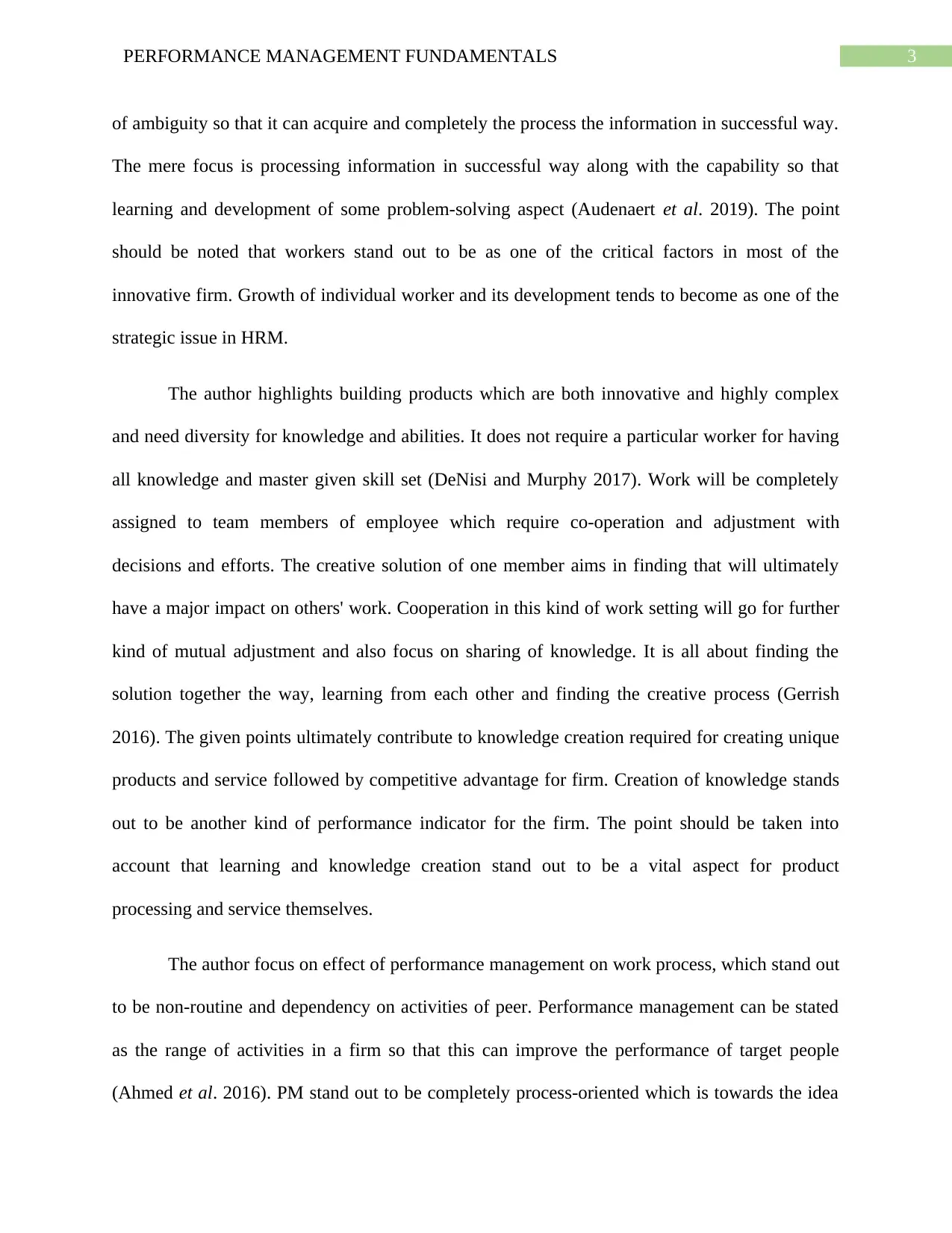
3PERFORMANCE MANAGEMENT FUNDAMENTALS
of ambiguity so that it can acquire and completely the process the information in successful way.
The mere focus is processing information in successful way along with the capability so that
learning and development of some problem-solving aspect (Audenaert et al. 2019). The point
should be noted that workers stand out to be as one of the critical factors in most of the
innovative firm. Growth of individual worker and its development tends to become as one of the
strategic issue in HRM.
The author highlights building products which are both innovative and highly complex
and need diversity for knowledge and abilities. It does not require a particular worker for having
all knowledge and master given skill set (DeNisi and Murphy 2017). Work will be completely
assigned to team members of employee which require co-operation and adjustment with
decisions and efforts. The creative solution of one member aims in finding that will ultimately
have a major impact on others' work. Cooperation in this kind of work setting will go for further
kind of mutual adjustment and also focus on sharing of knowledge. It is all about finding the
solution together the way, learning from each other and finding the creative process (Gerrish
2016). The given points ultimately contribute to knowledge creation required for creating unique
products and service followed by competitive advantage for firm. Creation of knowledge stands
out to be another kind of performance indicator for the firm. The point should be taken into
account that learning and knowledge creation stand out to be a vital aspect for product
processing and service themselves.
The author focus on effect of performance management on work process, which stand out
to be non-routine and dependency on activities of peer. Performance management can be stated
as the range of activities in a firm so that this can improve the performance of target people
(Ahmed et al. 2016). PM stand out to be completely process-oriented which is towards the idea
of ambiguity so that it can acquire and completely the process the information in successful way.
The mere focus is processing information in successful way along with the capability so that
learning and development of some problem-solving aspect (Audenaert et al. 2019). The point
should be noted that workers stand out to be as one of the critical factors in most of the
innovative firm. Growth of individual worker and its development tends to become as one of the
strategic issue in HRM.
The author highlights building products which are both innovative and highly complex
and need diversity for knowledge and abilities. It does not require a particular worker for having
all knowledge and master given skill set (DeNisi and Murphy 2017). Work will be completely
assigned to team members of employee which require co-operation and adjustment with
decisions and efforts. The creative solution of one member aims in finding that will ultimately
have a major impact on others' work. Cooperation in this kind of work setting will go for further
kind of mutual adjustment and also focus on sharing of knowledge. It is all about finding the
solution together the way, learning from each other and finding the creative process (Gerrish
2016). The given points ultimately contribute to knowledge creation required for creating unique
products and service followed by competitive advantage for firm. Creation of knowledge stands
out to be another kind of performance indicator for the firm. The point should be taken into
account that learning and knowledge creation stand out to be a vital aspect for product
processing and service themselves.
The author focus on effect of performance management on work process, which stand out
to be non-routine and dependency on activities of peer. Performance management can be stated
as the range of activities in a firm so that this can improve the performance of target people
(Ahmed et al. 2016). PM stand out to be completely process-oriented which is towards the idea
Paraphrase This Document
Need a fresh take? Get an instant paraphrase of this document with our AI Paraphraser
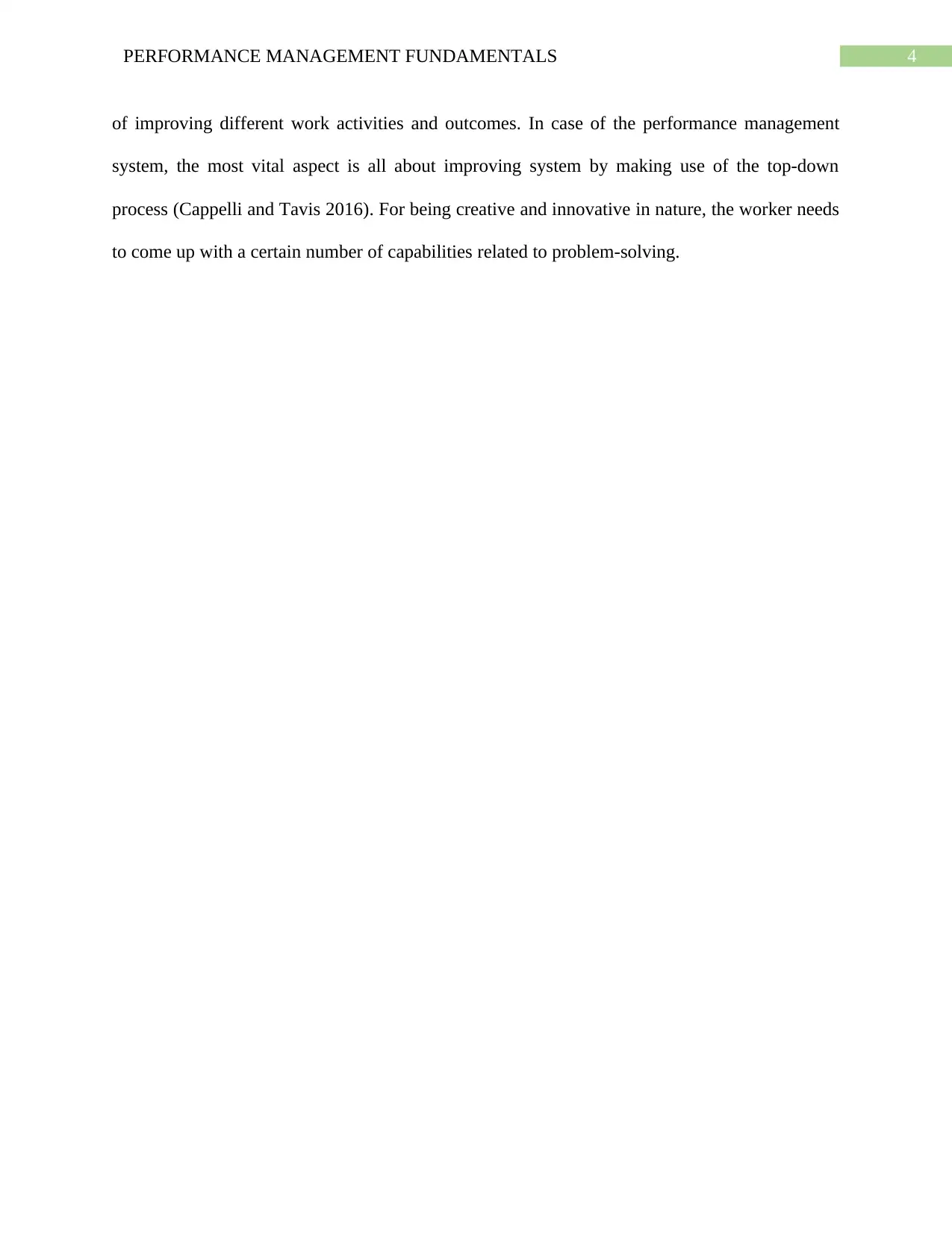
4PERFORMANCE MANAGEMENT FUNDAMENTALS
of improving different work activities and outcomes. In case of the performance management
system, the most vital aspect is all about improving system by making use of the top-down
process (Cappelli and Tavis 2016). For being creative and innovative in nature, the worker needs
to come up with a certain number of capabilities related to problem-solving.
of improving different work activities and outcomes. In case of the performance management
system, the most vital aspect is all about improving system by making use of the top-down
process (Cappelli and Tavis 2016). For being creative and innovative in nature, the worker needs
to come up with a certain number of capabilities related to problem-solving.
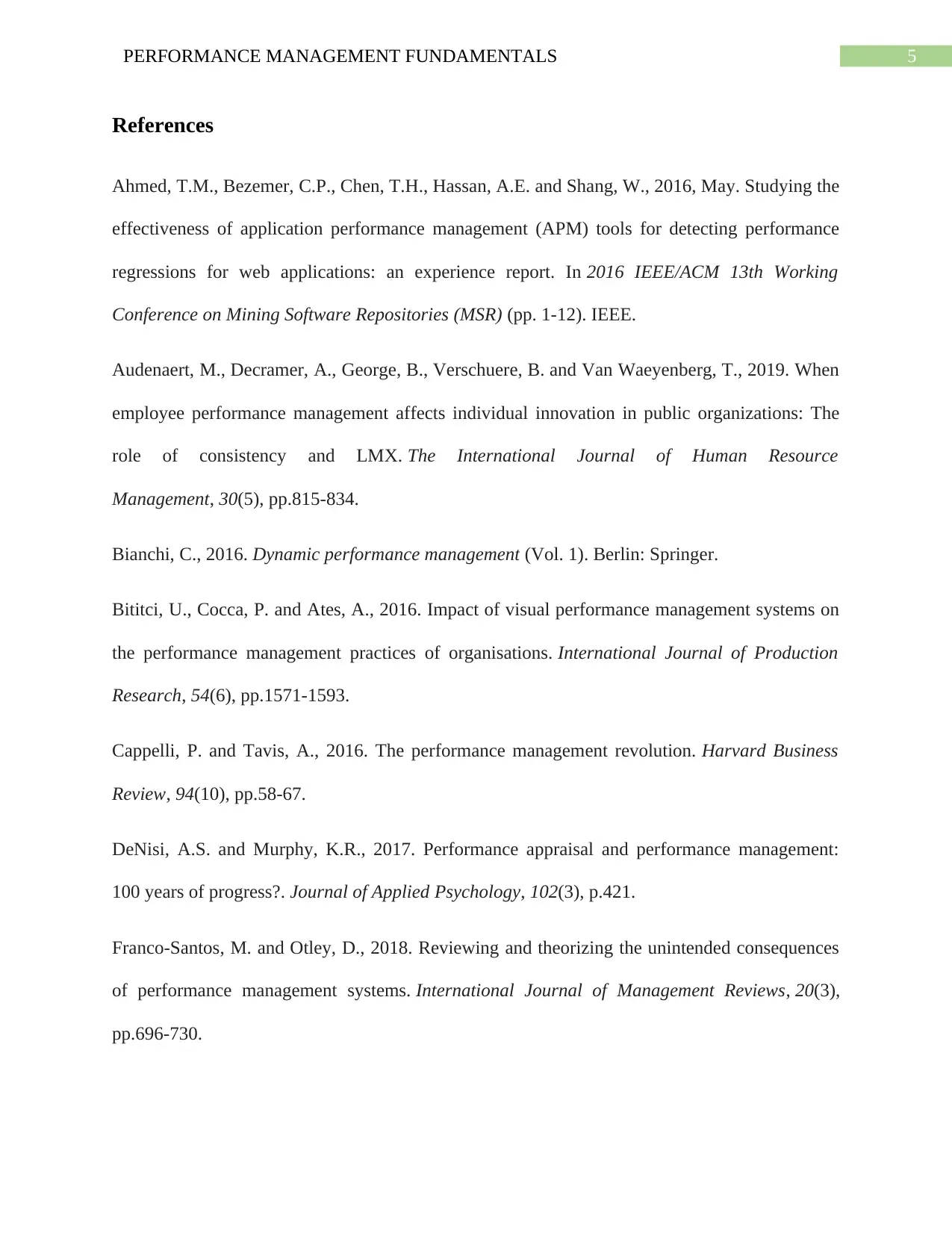
5PERFORMANCE MANAGEMENT FUNDAMENTALS
References
Ahmed, T.M., Bezemer, C.P., Chen, T.H., Hassan, A.E. and Shang, W., 2016, May. Studying the
effectiveness of application performance management (APM) tools for detecting performance
regressions for web applications: an experience report. In 2016 IEEE/ACM 13th Working
Conference on Mining Software Repositories (MSR) (pp. 1-12). IEEE.
Audenaert, M., Decramer, A., George, B., Verschuere, B. and Van Waeyenberg, T., 2019. When
employee performance management affects individual innovation in public organizations: The
role of consistency and LMX. The International Journal of Human Resource
Management, 30(5), pp.815-834.
Bianchi, C., 2016. Dynamic performance management (Vol. 1). Berlin: Springer.
Bititci, U., Cocca, P. and Ates, A., 2016. Impact of visual performance management systems on
the performance management practices of organisations. International Journal of Production
Research, 54(6), pp.1571-1593.
Cappelli, P. and Tavis, A., 2016. The performance management revolution. Harvard Business
Review, 94(10), pp.58-67.
DeNisi, A.S. and Murphy, K.R., 2017. Performance appraisal and performance management:
100 years of progress?. Journal of Applied Psychology, 102(3), p.421.
Franco‐Santos, M. and Otley, D., 2018. Reviewing and theorizing the unintended consequences
of performance management systems. International Journal of Management Reviews, 20(3),
pp.696-730.
References
Ahmed, T.M., Bezemer, C.P., Chen, T.H., Hassan, A.E. and Shang, W., 2016, May. Studying the
effectiveness of application performance management (APM) tools for detecting performance
regressions for web applications: an experience report. In 2016 IEEE/ACM 13th Working
Conference on Mining Software Repositories (MSR) (pp. 1-12). IEEE.
Audenaert, M., Decramer, A., George, B., Verschuere, B. and Van Waeyenberg, T., 2019. When
employee performance management affects individual innovation in public organizations: The
role of consistency and LMX. The International Journal of Human Resource
Management, 30(5), pp.815-834.
Bianchi, C., 2016. Dynamic performance management (Vol. 1). Berlin: Springer.
Bititci, U., Cocca, P. and Ates, A., 2016. Impact of visual performance management systems on
the performance management practices of organisations. International Journal of Production
Research, 54(6), pp.1571-1593.
Cappelli, P. and Tavis, A., 2016. The performance management revolution. Harvard Business
Review, 94(10), pp.58-67.
DeNisi, A.S. and Murphy, K.R., 2017. Performance appraisal and performance management:
100 years of progress?. Journal of Applied Psychology, 102(3), p.421.
Franco‐Santos, M. and Otley, D., 2018. Reviewing and theorizing the unintended consequences
of performance management systems. International Journal of Management Reviews, 20(3),
pp.696-730.
⊘ This is a preview!⊘
Do you want full access?
Subscribe today to unlock all pages.

Trusted by 1+ million students worldwide
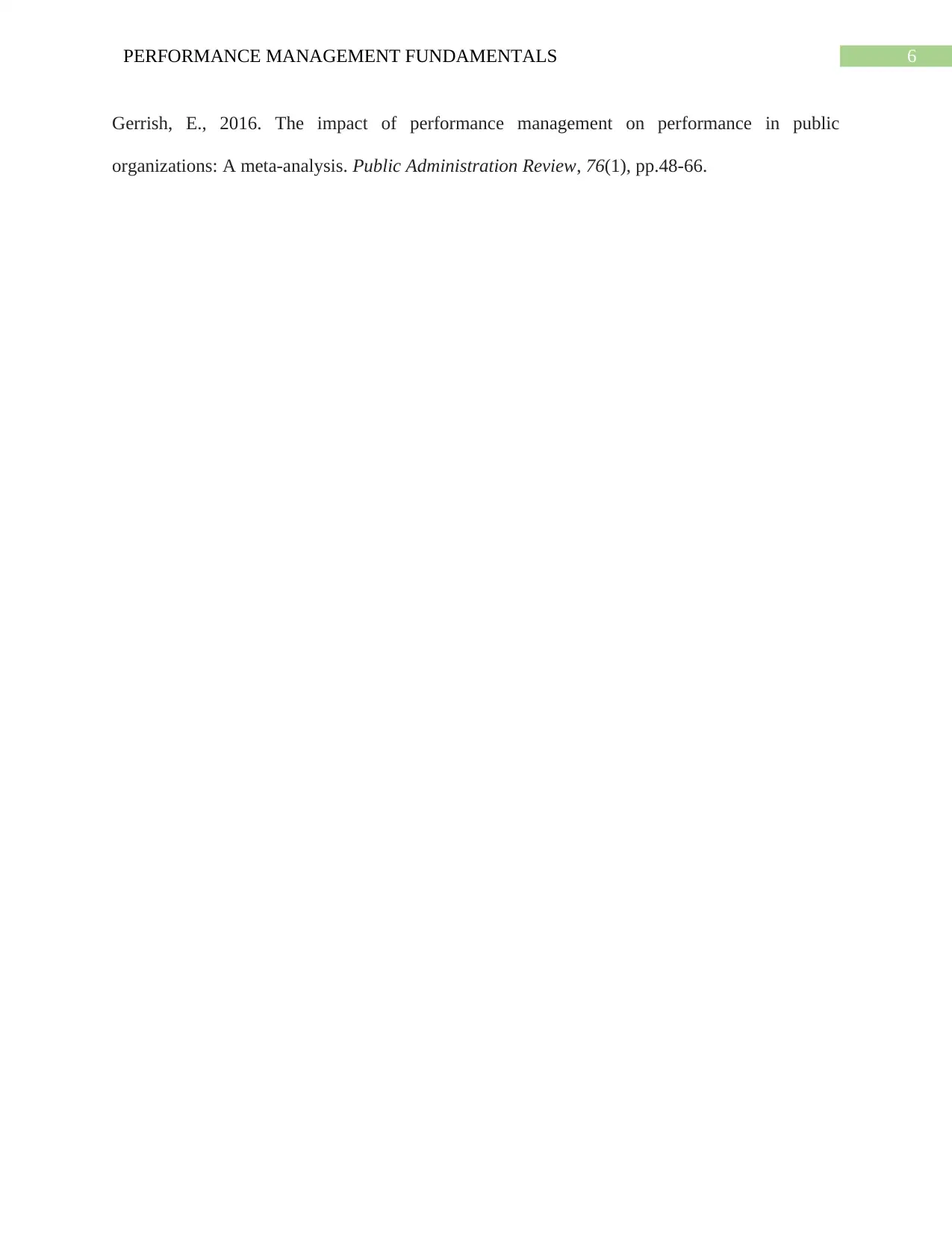
6PERFORMANCE MANAGEMENT FUNDAMENTALS
Gerrish, E., 2016. The impact of performance management on performance in public
organizations: A meta‐analysis. Public Administration Review, 76(1), pp.48-66.
Gerrish, E., 2016. The impact of performance management on performance in public
organizations: A meta‐analysis. Public Administration Review, 76(1), pp.48-66.
1 out of 7
Related Documents
Your All-in-One AI-Powered Toolkit for Academic Success.
+13062052269
info@desklib.com
Available 24*7 on WhatsApp / Email
![[object Object]](/_next/static/media/star-bottom.7253800d.svg)
Unlock your academic potential
Copyright © 2020–2025 A2Z Services. All Rights Reserved. Developed and managed by ZUCOL.





